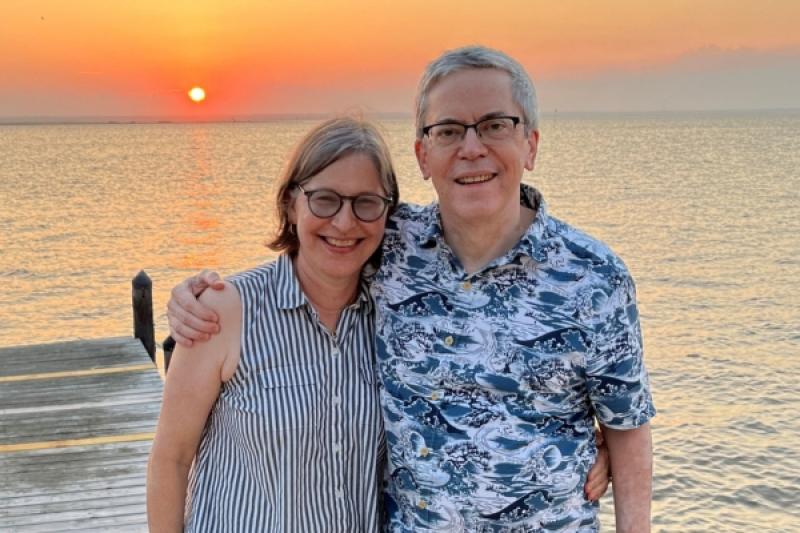George Mannes' Acral Melanoma Story
By Renee Orcione, MRA Digital Engagement & Communications Manager | 25 November 2024 | Melanoma Stories, Science, Treatment

George Mannes, a longtime writer and editor based in New York City, is sharing his acral melanoma journey in the hopes that more people will become aware of this lesser-known rare melanoma subtype. Acral melanoma, sometimes called acral lentiginous melanoma (ALM), forms on the palms, soles of feet, or under fingernails or toenails. Unlike the most common cutaneous (skin) melanoma, it is not believed to be caused by sun exposure. Acral melanoma is rare, accounting for only about 1-3% of all melanoma cases. This melanoma subtype can occur in anyone, but it is proportionately higher in people with darker skin tones, such as African Americans, Asians, and Hispanics.
First Signs of Acral Melanoma
For George, his acral melanoma journey began in an all too familiar place. As an avid marathon and distance runner, foot problems often come with the territory. In one instance, George lost a nail on his left big toe; when it grew back, the nail bed was slightly discolored. At his yearly skin check, George’s dermatologist took note of the discoloration, but after George explained its origin, she did not investigate further.
A few years later, however, George noticed a blood blister forming on his toe. He was referred by his primary caregiver’s office to a podiatrist. After a second referral, George found himself in the office of Dr. Bryan Markinson at Mount Sinai. Dr. Markinson was immediately concerned and did a biopsy. Within about a week, George received his official diagnosis: acral melanoma.
“I had no idea that this type of melanoma existed. My understanding of melanoma was that it had to do with the skin and sun exposure,” shared George. “My acral melanoma didn’t even have a racing stripe,” – the darkened streak or discoloration that runs up the nail bed in some cases of acral melanoma.
Developing a Treatment Plan for Metastatic Acral Melanoma
Following his diagnosis, George’s toe was amputated by Dr. Daniel Coit at Memorial Sloan Kettering Cancer Center (MSKCC). Dr. Coit also performed a sentinel lymph node biopsy (SLNB), which revealed that George’s melanoma had spread. Under the care of Dr. Alex Shoushtari at MSKCC, George began immunotherapy, but his melanoma returned after a year.
Dr. Shoushtari then changed George’s treatment plan, putting him on imatinib, a chemotherapy pill used to treat leukemia and other cancers. In melanoma, some patients may be able to take imatinib if their tumor has a specific mutation, such as cKIT.1
Not long after starting on imatinib, George developed an allergic reaction—rashes and severe itching over much of his body. He accepted an invitation to join a clinical trial testing the use of benralizumab injections—normally used to treat a certain type of asthma—to treat the side effects of imatinib. The injections while on the trial appeared to clear up his skin issues.
After 16 months on imatinib, however, George’s melanoma returned. Dr. Shoushtari prescribed a series of injections of imlygic, a type of viral therapy used to infect and kill melanomas. As of late November 2024, it’s too early to tell how effective this treatment will be for George.
Raising Awareness of Acral Melanoma
Reflecting on his journey, George expresses some frustration with his former dermatologist for not warning him about the risk of developing acral melanoma. Although there is currently no definitive link between trauma and the development of acral melanoma, some studies have demonstrated an association.2,3
Greater awareness of this more uncommon type of melanoma among doctors and the general public could lead to earlier diagnoses and better outcomes. George is particularly impressed by Dr. Markinson’s "More Eyes on Melanoma" campaign, which is intended to raise awareness among a group of people who are especially well-positioned to notice the early signs of acral melanoma: nail techs working at nail salons.
In the hopes of helping the greater good, George joined MRA’s RARE Registry, a registry for patients with acral, mucosal, and cutaneous melanoma. The registry enables the sharing of information, experiences and disease history, ultimately helping to advance research and awareness.
George also told his story in public earlier this year, performing a thoughtful and sometimes humorous monologue at a New York City event hosted by the organization Writers Read. “I had 59 good years with that toe,” he said, “We were, in a word, inseparable.” Watch George’s full monologue below:
